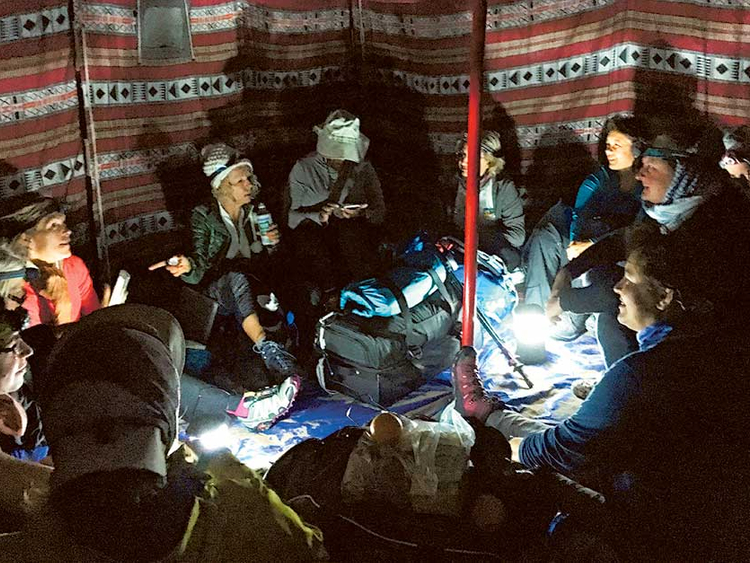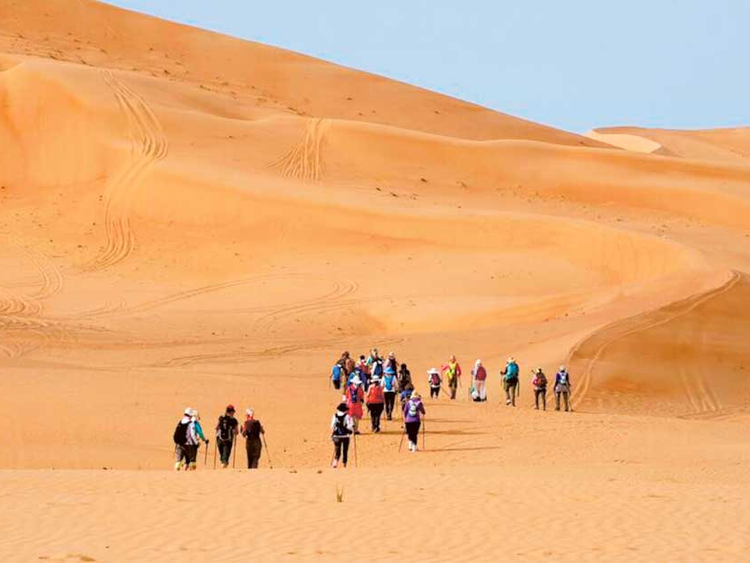
Abu Dhabi: Who would have thought that a simple walk in the desert could transform lives? When 50 women, comprising Emiratis and multinational expatriates, come together to walk 125km from Al Ain to Abu Dhabi, they discovered that it really can change lives.
The annual Women’s Heritage Walk started three years ago and has had phenomenal success. The aim of the walk is simple — provide an opportunity for women from all walks of life to get a glimpse of the role Emirati women played back in the day when they had to travel on foot, and with camels, with their families between Abu Dhabi and Al Ain, a trip that took place twice a year, with the change of season.
So popular has the Heritage Walk become that there was a waiting list this year of around 200 women, with participants admitted on a first-come first-serve basis. Each woman had to provide a clearance note from her doctor and commit to a three-month training programme.
However, the Heritage Walk has become more than just a walk to learn about heritage. Gulf News joined the group of women who took part in the 2017 edition to get a better understanding of how the event is helping women from across the world understand Emirati culture, and form deep friendships.
The Women’s Heritage Walk started at Al Ain’s Oasis, with the support of the Abu Dhabi Tourism and Culture Authority (TCA Abu Dhabi) on February 9. Fifty women of 20 nationalities were to walk for six days and arrive in Abu Dhabi on February 14.
A support team that involved 4x4 cars, an ambulance service, and organisers for catering and setting up camps also joined them — a luxury all participants were all too aware was not available to Emirati women in the old days.
At the walk
A typical day at the walk has the alarms go off at about 4.30am at the campsite. Waking up to a quiet, beautiful predawn in the outdoors is a novel experience for many women more used to the city mornings. Soon after breakfast, the day’s walk commences, which is about 30km.
The women, or Sand Sisters as they call each other, are divided into groups based on their pace. Each group has a leader, with the last group calling themselves the Sand Turtles.
The long walk through the desert, its silence like a noise-cancelling device of nature, offers its own rewards. As one puts one step in front of the other, absorbing the quietness, the mind turns self-reflective. In between the silences, there are also opportunities to speak with the women in your group and learn about them, and many times learn from them.
By around 11.30am, the groups of women arrive at a campsite all ready for lunch, followed by a couple of hours of rest. It is a welcome respite. Shoes and socks are the first to come off, and bags are hastily dropped on the sand as the break affords everyone a chance to relax.
Some opt to lie down under the shade of the tent while others relish the meal and strike up conversations with members from other walking groups.
It is heart-warming to observe how easy it is to bond with each other. Throughout the walk, the women, total strangers not so long ago, are now sharing an easy camaraderie, checking up on each other to ensure they are eating properly and drinking enough water for the next stretch of walk ahead.
The conversations are as interesting as they are intriguing. You find yourself learning new things, between bursts of laughter punctuating the growing familiarity.
Walking on after lunch, it is 6.30pm and the gathering darkness brings everyone to the overnight camp.
A word on walking in the desert. No matter how comfortable your shoes, they will press down on your toes, you will feel those nails digging into your flesh and at times, even feel as if they are snapping off from the root. Blisters are common as are muscle aches. One of the women even warned me that my already short toenails should be cut even shorter or they would cause unnecessary grief. She was not wrong.
Before settling in for the night, it is time to limber up the body after a day of walking.
Dinner by a beautiful campfire is a further opportunity to make new friends, or simply let your mind settle into a deep reflection of life.
The night ends early and by 8.30pm, most women have already packed their bags for the next day’s walk and are ready to turn in.
The sandstorm
The silence of the desert is broken with the high-pitched whistle of high winds buffeting the tents.
“Help! Our tent is down!”
It is 10pm and screams of laughter rise into the air as the women shout for help in one tent.
The support team acts quickly to help put their tent up again. But half an hour later, another round of shouts from a another tent go up asking for help. This continues through the night as tents give in to the bullying of the wind and the support team, who are also due to prepare breakfast at 4.30am are instead attending to putting the tents back up.
Finally, by 3.30am on Monday morning, after close monitoring of the weather forecast, we are given the disappointing news that it would not be safe to continue the walk. We are told that we will be evacuated from the campsite by cars.
As we wait to be evacuated, the time is spent telling stories, jokes, sharing food and reflecting on the journey. The energies are so high, you wouldn’t imagine that these women had walked 90km in the desert, and gotten close to no sleep the previous night.
The sandstorm also made many ponder the sheer tenacity of Emiratis who made those desert journeys back in the day.
Strength, support, perseverance, love, tolerance, calm during hardships, and looking to the bright side of things in tough situations are just a few lessons that come to mind during my short stay in the desert with 50 of the most incredible women I was fortunate to be with.
How was the walk founded
In 2010, American author and therapist Jody J. Bollard, who was then living in the UAE and researching for her book, Whispers from the Sand (awaiting publication), decided to focus on Emirati culture and heritage. “I needed to understand the traditions and the daily habits that come from the hardships of living in the desert,” said Bollard.
With the support of a number of people, Bollard started the first Women’s Heritage Walk three years ago.
She contextualises the incredible Emirati hospitality by referencing the need to always reach out to people in the desert.
“It is really sometimes life or death (in the desert); if you come across someone and they are willing to share water or food with you, [it alters everything].”
The heritage walk necessarily comprises the participation of 50 per cent of Emirati women and 50 per cent expatriate women. Many expats in the UAE do not get the opportunity to mix with Emiratis and the walk presents the perfect setting to do so.
Although Bollard moved to Hawaii in 2015, with the support of a team here, she manages to keep the event going.
Cultural exchange
Cindy Dodge, 54, American expatriate based in Abu Dhabi
Dodge, decided to take part in the walk because it provided an opportunity to learn about the history of the UAE and spend more time with women who wanted to do the same thing.
“This experience has given me the opportunity to learn so much about the Emirati and Arab culture. The time you spend with other women [makes you] ask each other a lot of questions and with every question, you get to know each other better,” said Dodge.
Dodge used the experience of watching some of the Emirati women pray at lunch time as an example. “We asked them what they prayed for — was it a script or something in specific that they asked for.”
“I learnt that it is a script and the women said it was about asking for continuous guidance from God throughout the day.”
Swason Al Ghulifqi, 31, Emirati living in Abu Dhabi, manages real estate
Al Ghulifi said she had taken part in many adventurous walks abroad but never in the UAE.
“It was a great experience because we got to learn about each other’s cultures and I was so happy to tell the other women about our culture in the UAE.”
She said she shared what she knew about her forefathers and how they travelled from one location to another in the desert whether it was to see their families or seek water.
She also decided to do the walk barefoot, which surprised some of the other women.
“I told them that this is how our ancestors used to do it before, they didn’t have high-quality hiking boots those days.”
She said food was another hot topic of discussion among the women, and she was happy to share with them tips on Emirati food.
TCA Abu Dhabi
“The TCA has proudly supported the efforts of these phenomenal women primarily by providing access to resources that will help them to have the most authentic experience,” said Ranya Nasser, Head of Education Programmes and Initiatives at TCA Abu Dhabi.
“Starting off their walk in the Al Ain Oasis was very symbolic. Historically, people walked from oasis to oasis as they made their way across the desert.”
TCA Abu Dhabi also provided the women with material about traditional handicrafts, intangible heritage elements inscribed by Unesco, and arranged Al Taghrouda experts to join their camp in the desert and recite traditional poetry.
“TCA Abu Dhabi is supporting the event because one of our missions is to educate and engage the public in the many rich traditions of Emirati heritage and culture.
“Bringing people from diverse backgrounds together through a cultural event can be very powerful and moving,” Nasser said.
On one of the days of the Heritage Walk, the TCA arranged for a couple of Al Taghrouda singers, traditional Emirati singers, to join the women at the camp. They sang, told the women stories and performed traditional Emirati dances. A few of the women even joyously participated in the traditional dance that has women waving their hair from side to side. It was a lot more challenging than it looks, said one of the participants.













